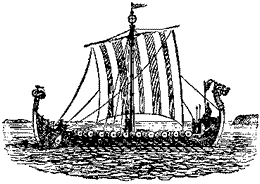If you need help remembering the parts of the TDM click here  (Word doc) or here (Word doc) or here  (rtf). (rtf). 
Criteria and Constraints:
- Your boat must float
- Your boat must be powered by the wind.
- Your boat must reach it's intended target using only the rudder you design.
- Your rudder can be located on any part of the ship's hull.
- You can have as many rudders as your want on your ship.
- You may not interfere with your boat during the voyage.
- Your target is a spot on the opposite end of the body of water that is no more than 4 inches wide.
- The target may not be directly in front of the ship's starting point. It must be to the left or right of the starting point.
Background Information: Most modern boats have at least one rudder at the back of the ship to steer it through the water. Not all ships have a rudder in the back. The Vikings were the masters of the open waters when they reigned over the Nordic seas. Their innovative ship designs allowed them to strike quickly during battle. An innovation by the Vikings was the use of a side mounted rudder. The side mounted rudder also had a design that allowed it to be quickly raised out of the water allowing the ship to sail right up to the beach instead of anchoring off shore.
Materials
- Aluminum foil for the ship's hull
- Heavy bond paper (Card Stock) for use as a sail
- Index card for use as a rudder
- Tape
- Craft sticks or wooden coffee stirs for the mast and/or rudder
- Wind source (such as a battery operated fan)
Presentation: Complete the design folio using either of the two templates below:
- Design Folio in
 (Word doc) or (Word doc) or  (rtf) format. (rtf) format.
- You may also create your Design Folio in PowerPoint format
Questions to consider:
- How did the size and shape of the rudder affect the course of the ship?
- How much of a role do you think the hull design plays in the ability to keep a ship on course?
- Does the wind play a part in steering the boat toward the target? How do you compensate for this?
Assignment: Rudder Design
Evaluation: After you complete this project, you will complete the rubric that is included in the Design Folio Template. You will describe your troubleshooting methods in the "Evaluation" section of the Design Folio. Use the "Questions to consider" to help guide you. Then upload your completed Design Folio to the Troubleshooting drop box. |
|
